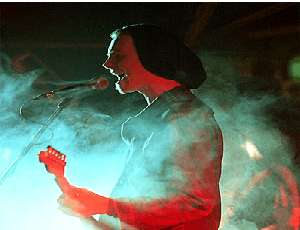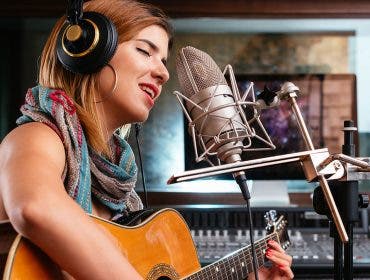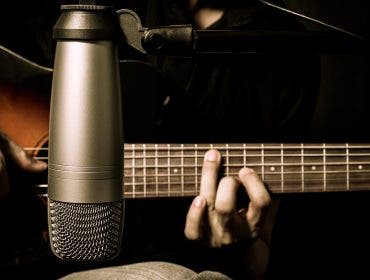If you are a fan of live music, capturing exciting and potentially profitable images of your favourite performers is well within the range of most photographers.
Also see: The Adorama Learning Center celebrates MTV’s Video Music Awards
The key ingredients to make a great concert shots are photo dramatic lighting, creative composition, an interesting moment, and technical excellence. Flash has its purpose for certain gigs, but I prefer available stage light; here’s how I take advantage of it.
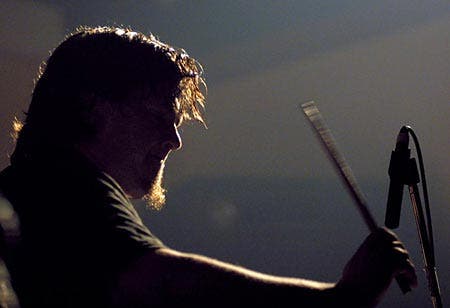
Shallow depth for dramatic impact: I photographed the percussionist for the group The Jimmy Cake with my Canon 10D and 85mm f/1.8 lens at 1/125 sec and f/1.8, with the ISO set to 800.
Because concert shooting is a combination of low-light and action photography, a reasonably fast shutter speed is usually desirable. Though using a tripod or vibration reduction can result in very dramatic and artistic stage photographs, the motion blur of the performers is not usually suitable for press or PR work.
I switch between film and digital cameras. As the light on the performers is often quite dim, and can contrast dramatically with the background, three things are usually imperative. Use your fastest lens wide open (f/2.8 or faster preferably) high speed film or high digital ISO setting (400 or higher), and spot or partial metering.
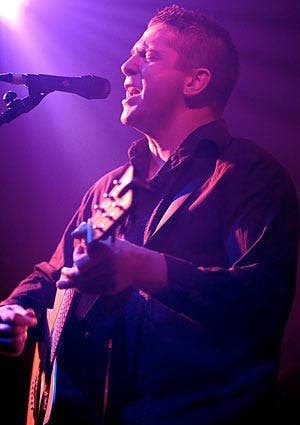
Use the light: Stage spotlight adds a dramatic flare to this photo of singer Damien Dempsey. Camera: Canon 10D, with 85mm f/1.8 lsns; exposure: 1/160 sec at f/1.8, ISO 800.
On my Canon EOS bodies I use either an 85mm f/1.8 or 50mm f/1.8, and and I also have a Konica Hexar, a 35mm rangefinder with a built-in 35mm f/2 lens. (While this model has been discontinued, there are other 35mm rangefinders currently on the market.)
When shooting film I use Kodak T-Max 3200 for black and white, and Fujifilm Pro 800Z print film for color. If using extremely fast film like ISO 3200 (which can be pushed to ISO 6400), you can get a fast enough shutter speed even with an f/5.6 lens. However, these days with the latest advances in sensor technology, DSLRs such as the Canon 7D, Nikon D7000 and Sony A-580 offer outstanding low-light image quality.
Take the color’s temperature
When shooting under stage light in color, the color temperature of the lights need to be taken into consideration, or else a strong red color cast will result. Tungsten-based film or a color correction filter with daylight film should be used. I use an 80B color correction filter with Fuji 800 Press, overexposing the film 2/3 of a stop to compensate for of the filter factor. I always shoot Camera RAW, and set the camera’s white balance to Tungsten. I find I can do most of the color tweaking when opening it from RAW. Coming up with a system you are comfortable with may take a bit of practice.
Get Clearance
Shooting in a music venue should always be cleared by both a venue and performer representative. There may be specific rules to adhere to. As you progress up the gig ladder, this gets even more important so doing the advance work is a good habit to get into. It is also a great way to make contacts.
If I happen to be shooting where other serious photographers are as well, I touch base with them too. And, as I’ve been a lover of live music longer than I’ve been a music photographer, it’s good to keep in mind that the rest of the audience is there to watch the performance and not you. Don’t be overly shy about getting a good shot (especially if you are there on assignment), but try to be polite about it.
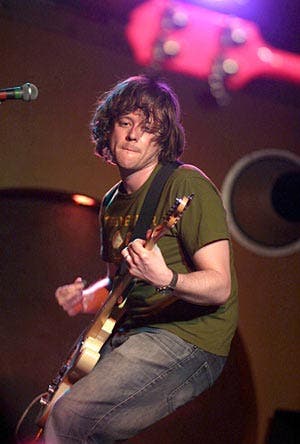
Watch the expressions: Iain Archer’s really getting into his guitar solo here–a good moment! 1/125 sec at f/8, same camera and lens as above.
Once at the performance and okayed to shoot, move around a bit and pick a good vantage point. You may be able to move later on in the show, but if it gets crowded you may be locked into one location, so pick a spot you are confident will allow you to get good shots. I usually shoot off center because I don’t like microphones directly in front of faces. However, if the stage is quite high or you are shooting from a balcony, shooting from the center could be quite effective. This is where your eye takes over. Trust your judgement as there are no real rules, just general guidelines for nailing that winning shot.
The light will probably vary throughout the show, but take a couple light readings or practice shots on a digital camera just to get a feel for the light. As mentioned earlier, you should only meter the subject. Otherwise, the background will throw off the exposure. Use spot or partial metering. If you don’t have this option, zoom in to get a reading of just the subject. (If you zoom in to take a meter reading, keep in mind that your lens’s tele setting may not have as wide an aperture as its wide angle setting, so you may have to do some quick calculations; for example, an f/5.6 max aperture at 200mm may yield a 1/30 sec shutter speed, but at 80mm at a max shutter speed of f/2.8, the shutter speed becomes 1/125 sec.)
At my main venue, I tend to shoot at ISO 800 and f/2 with my camera set at aperture priority, with either my 85mm or 50mm lens. Depending on the brightness of the lights, this gives me a shutter speed range of 1/160 to 1/30 sec. (Light varies due to the preference of the act, the lighting technician, and during some performances, the light will vary in intensity throughout, adding to the atmosphere. In this case it is best to use an aperture or shutter priority mode.)
At the higher end of the shutter speed range I can pretty much bring the camera up with one hand, achieve focus and snap a sharp shot. At the lower end, especially with the longer lens, it’s deep breath, with both arms supporting camera and a burst of four or five shots on motor drive or burst mode. The first and last are usually blurry due to the motion of my finger on the shutter, but the ones in the middle are often usable.
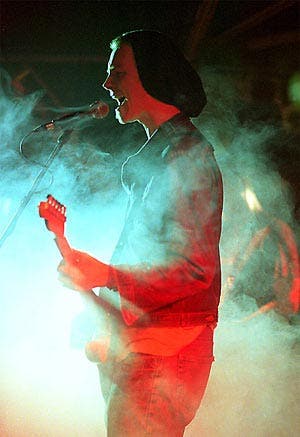
Catch the atmosphere: Dramatic smoke and stage effects are gifts to concert photographers. The red on Label’s face is from the stage lighting. Canon A2, 85mm f/1.8 lens with Fuji Press 800 and an 80B filter. Exposure: 1/90 sec at f/1.8.
Choosing the moment is all up to you. As you get a feel for the light and the performer, watch for dramatic lighting situations (back-lighting, rim-lighting, stage smoke). A good animated moment, like screaming into the mike, is always a winner, but don’t forget the shots of the performers in repose or between songs. Shots of performers interacting with each other or the audience are great, as are catching any unusual or unexpected expressions or moments.
As for composition, again use your own judgement. If it looks good and interesting, take it. Play around a bit. I like to shoot through other musicians to get a sharp shot of one face, with blurred equipment in the foreground. Much of this depends on your vantage point. If shooting a high stage with a wide angle, you have different compositional possibilities than if you are in the front row of a small singer-songwriter show with a longer lens. If you are hired by the venue or act, it’s always good to try to get their logo in the shot if possible.
Don’t adhere too strictly to the technical rules if your instincts take over. Develop your own style. Show the acts, venues, and press your shots, and hope for the best. Perks will probably come before pay, but don’t make that a habit. Your time, gear, and experience are valuable, so negotiate proper compensation for any work used.
Finally, never forget to enjoy the music. It may be work, but there are worse ways to spend a night.
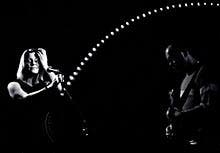 Taking care of business
Taking care of business
Finding and approaching clients is rather straightforward if you are confident that you have strong images.
The main clients are the press, the venues, and the acts themselves. Many times you will find yourself dealing with all three at different stages, which makes usage and payment a bit complicated.
All these clients can simply be e-mailed some low-res images, which is quick and easy (especially if the clients aren’t local), but nothing beats meeting in person and the impact of showing prints.
The press (from the local free rag up through international magazines and newspapers) use live photos to accompany reviews and previews, and occasionally as stand alone images. Sharp photos with good contrast and recognizable performers are the most important thing to aim for here. Show a few to local editors and you may be asked to cover upcoming gigs or to provide stock as needed. Staff photographers often cover this area, but it is sometimes the domain of freelancers.
Music venues often decorate their premises with images (prints, posters, transparencies, etc…) of memorable concerts, so show the venue manager to see if there’s interest. Best to make the stage recognizable as well as the act if possible. Venues also need images for their PR materials and websites, so you may be able to negotiate further usage rights. This assumes the venue does not already have a house photographer, but you would probably know by this point.
Finally, the acts themselves always need to good images for their press kits and websites as well, so be sure to touch base with them. Again, don’t be surprised if you give an act a photo and then see it endlessly reproduced. Negotiate usage rights. The press won’t pay you if they use your photo but the band submitted it.
Newspapers and magazines often have a set rate, the venues are much more flexible, and the acts are often broke. Price your work accordingly.
